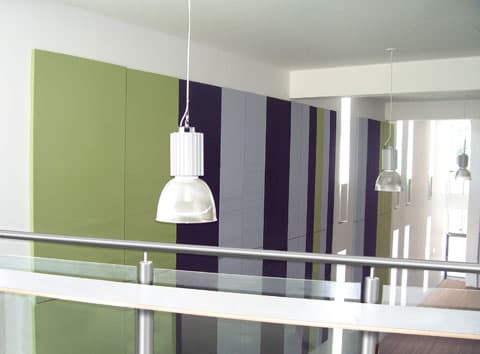
REVERBERATION TIME CALCULATIONS
Office spaces are usually much larger than normal domestic room settings and feature large areas of the hard reflective surface which if left untreated simply encourage to echo around a room. Understanding reverberation and accurately measuring it is an essential part of achieving an acoustic solution in the office.
Unless correctly treated with soundproofing and sound absorption materials, large open plan workspaces suffer from a phenomenon known as reverberation.
Surfaces can absorb, block or reflect sound waves. Generally the harder and smoother a surface, like glass or wood, the more sound it reflects. In offices, which typically have large areas like this, reflected energy accumulates within the room, raising the noise level. In turn, this causes people to speak louder in order to be heard, thereby raising the noise level in the room even further.
Reverberation is the persistence of sound in a particular space after the original noise source is removed. Also known as echo, this reverberation is created when a sound in an enclosed space causes a large number of echoes to build up and then slowly decay as the sound is absorbed by the walls, air and other surfaces and objects in the room.
The length of this sound decay, or reverberation time, is a vitally important consideration in the architectural design of large spaces which need to have specific reverberation times to achieve optimum performance for their intended activity. Understanding reverberation times in particular workspaces helps design the most appropriate soundproofing and sound absorbing solution.
In the late 19th century, Wallace Clement Sabine started experiments at Harvard University to investigate the impact of absorption on reverberation time. Using a portable wind chest and organ pipes as a sound source, a stopwatch and his ears, he measured the time from interruption of the source to inaudibility (roughly 60 dB). He found that the reverberation time is proportional to the dimensions of the room and inversely proportional to the amount of absorption present.
Basic factors that affect a room’s reverberation time include the size and shape of the space as well as the materials used in the construction of the room. Every object placed within the workspace can also affect this reverberation time, including people and their belongings.
In theory, it is easy to determine the reverberation time of a room. It depends on the volume of the room and the rate at which the sound energy is absorbed by the wall surfaces and the objects in the room. In a bare room, the reverberation time is thus proportional to the ratio of volume to surface. It is customary to define the reverberation time as the time required for the sound level to decrease by 60 dB (hence the abbreviation RT60). In 1922 a pioneer in the study of room acoustics, Wallace Sabine came up with the formula which is still used today.
Absorption solutions for all noise frequencies, lows, mid and high end need to be taken into consideration when designing an effective sound solution for a workspace.
Need to speak to an Acoustic Expert?
Please fill in the short form below and one of our acoustic consultants will be in touch to answer your questions:
